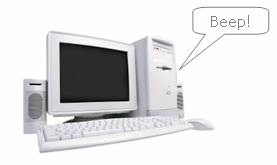So, your computer won’t start? On top of it, it sends out a beep(s) that seems like an SOS from the Titanic and you are worried that there is a serious problem with your computer.
Agreed, there is definitely a problem, but what is it?
How do you say what is the trouble without contacting the service centre?

When you power on the PC, the BIOS runs a diagnostic test, known as Power-On Self Test (POST). (What the heck is BIOS? BIOS is the acronym for Basic Input/Output System. BIOS is the software that is responsible for loading the operating system e.g. windows, mac etc. The POST is run by the BIOS to ascertain that the hardware is functioning properly).
In case the BIOS encounters an error, and it is unable to access the video card to display the error, it will “beep” out the message.
Beep Codes are the pattern the BIOS follows in order to point out which specific hardware is causing the problem.
These patterns will differ, primarily because of two reasons:
• The type of BIOS (basically three – AMIBIOS, Award BIOS and Phoenix).
• Type of motherboard - Different motherboard manufacturers use slightly customized codes.
Following is a list of AMIBIOS beep codes:
1 Beep : Refresh failure
2 Beeps : Parity error
3 Beeps : Base 64K memory failure
4 Beeps : Timer not operational
5 Beeps : Processor error
6 Beeps : 8042 - gate A20 failure
7 Beeps : Processor exception interrupt error
8 Beeps : Display memory read/write failure
9 Beeps : ROM checksum error
10 Beeps : CMOS shutdown register read/write error
11 Beeps : Cache memory bad
Now, excepting the 8 beep code, almost all other errors are fatal.
So, you know the beep code stuff and you can most probably tell what’s the nature of the problem with your computer. But after that, what?

Lets say you have a memory error and that includes the 1-3 beeps. The possible reasons are that:
1. If it’s a newly updated system, the memory type might not be compatible.
2. The memory might not have been stuck in properly.
3. The memory might have just gone bad.
Out of the above cases, cross-check with your vendor if there is a compatibility issue between the memory and the motherboard.
Then check the slots to make sure that the memory has been put properly in place. Finally if nothing works, get a new memory stick!
There is still one more issue that we didn’t talk about and that is a problem with the motherboard, in which case, you would still get a problem showing that the memory is causing an error whereas the mother board would be the real culprit.
For a 4-beep error, ‘timer nor operational’, one possible reason is that the mother board might be grounded (which is not such a good idea). Just check for any metal parts that might be causing the grounding, else, check if the mother board has been tightened too much. In absence of both, you can refer to your vendor if there is a hardware problem with the motherboard.
A 5-beep error signifies a processor problem. Either there is problem with the processor or motherboard or, there is a compatibility issue between the motherboard and the processor (if it is an assembled one). For starters, you can remove the CPU (please don’t do it if you don’t know how to – refer to a technician!) and reinstall it. If that doesn’t work, check with a new CPU compatible with your motherboard. Finally, check the mother board if there is a problem.
For a 6-beep error, the probable reason might be your keyboard. Check if the system is working with another keyboard. If that doesn’t work, reinstall the keyboard controller chip and if the problem persists, replace it. Check if the system is working with another keyboard.
(For a 5, 7 or 10-beep error, refer to the 4-beep error.)
For an 8-beep error, most probably, the video card memory is at fault, or some other part on the video card. Else, an incompatibility between the video card and the motherboard could be a problem.
A 9-beep error is a signal that the BIOS chip is at fault, which is a pretty serious problem and the motherboard parts/whole motherboard needs to be replaced for that.
(The above analysis is just for the AMIBIOS. However, for the same problem, only the mode of indication is different for different BIOS.)
Visit bioscentral.com for beep codes for all types of BIOS.

